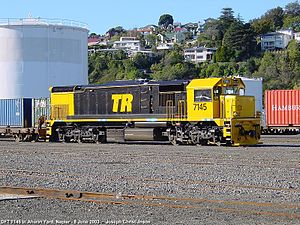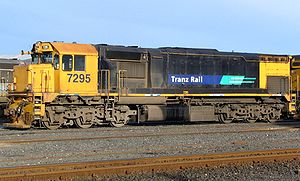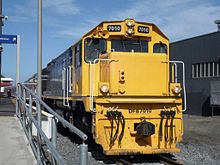- NZR DF class (1979)
-
NZR DF / DFT class (General Motors) 
DFT 7145 in Ahuriri Yard, Napier - 8 June 2003. Photo by Joseph Christianson.
DFT 7295 in Dunedin in former Tranz Rail "Bumble Bee" colours.Power type Diesel-Electric Builder General Motors Diesel (GMD), Canada (builder)
Tranz Rail (rebuilder)Model DF EMD GL22MC
DFT EMD GT22MCBuild date 1979 - 1981
1992 - 1997 (rebuilt as DFT class)UIC classification Co-Co Gauge 1,067 mm (3 ft 6 in) Cape gauge Length 16.7 metres (55 ft) Weight on drivers 86 tonnes (85 long tons; 95 short tons) Locomotive weight 86 tonnes (85 long tons; 95 short tons) Prime mover GM 12-645 Engine RPM range 900 rpm Aspiration Roots blower (DF)
Turbocharger (DFT)Displacement 126.84 litres (7,740 cu in) Traction motors Six D29cc Cylinders V12 Cylinder size 230 mm × 254 mm (9.1 in × 10.0 in) Top speed 113 km/h (70 mph) Power output 1,230 kW (1,650 hp) DF
1,800 kW (2,400 hp) DFTTractive effort 198 kN (45,000 lbf) Number in class 30 Number 1651 - 1670[n 1] (original DF)
6006 - 6317 (TMS DF)
7008 - 7348 (DFT)Locale All of New Zealand First run 1978 Disposition In service The NZR DF class of 1979 is a class of 30 Co-Co diesel-electric locomotives built by General Motors Diesel of Canada between 1979 and 1981. Between 1992 and 1997, all the locomotives were rebuilt as the DFT class, a turbocharged version of the DF.
The class should not be confused with the English Electric DF class of 1954; as all of the old DFs had been retired by mid-1975, the 'DF' classification was free to be re-used.
Contents
Introduction
The first 20 members of the DF class arrived in New Zealand in 1979, and initially ten worked on the East Coast Main Trunk, Kinleith, Rotorua and Murupara Branches, and ten worked freight trains on the Main North Line between Christchurch and Picton. At the time, they were the most powerful locomotives in the South Island, with a total power output of 1,230 kilowatts (1,650 hp).
The next ten DFs arrived in 1981 and were also sent to work in the Bay of Plenty, and some to supplement the South Island fleet, which by this time had also entered service on the Main South Line and Midland Line as far as Arthur's Pass.
In 1986 the DF fleet was reallocated, concentrating 22 of the class in the South Island, and reallocating the remaining eight North Island DFs from Hamilton to Wellington, for use between Wellington and Gisborne, on the Wairarapa Line and Palmerston North - Gisborne Line (PNGL).
In 1988, the fleet was again reallocated due to the opening of the NIMT electrification, with approximately 20 DFs based in Auckland for use in Northland and between Auckland and Tauranga and the remaining units based in the South Island. This reduced the DFs from the lower North Island - Gisborne routes, and the reduced the number in the South Island. Being such handy units this class sees far more inter-island transfers than the other classes. The allocations in the class register below can only be taken as a guide.
Like the DCs, the DFs were powered by an EMD 12-645 engine, delivering the same power output, but were able to make greater use of that power by having six traction motors, unlike the four traction motors of the DCs with their A1A-A1A wheel arrangement. The Co-Co wheel arrangement had several advantages: it gave the DF a tractive effort of 198 kN (45,000 lbf) and a maximum speed of 113 km/h (70 mph), compared to the DC's 140 kN (31,000 lbf) and 90–100 km/h (56–62 mph), . The most noticeable visual difference between the DF and the DC was the headlight arrangement on the cab: the DC had the lights arranged horizontally, while the DF had them arranged vertically. The DF is also considerably longer than a DC.
Upgrades
The locos received an upgrade in the late 1980s to improve visibility for the driver - this involved a large single front window replacing the original configuration that had two small windows instead.
Rebuilding to DFT
The main downside to the DF was the lack of power output from the diesel engine. This hindered the DF when it came to haulling heavy freight trains out of multiple.
In 1992, DF 6260 was rebuilt with a new turbocharged diesel engine and some other minor alterations. The rebuilt DF was reclassified DFT (the T standing for turbocharged), and was renumbered 7008.
After 18 months of trial, the remaining 29 DF were converted to DFTs, with the last converted in 1997. The turbocharged locos can now generate 1,800 kW (2,400 hp), and now comfortably fits between the DC class and the DX class in terms of power output.
Sub-classes
DFTs fitted with Maxitrax wheelslip control received an internal sub-classification of DFM in the early 2000's. This was an internal designation only, used in the Amicus computer system, and the classification was not applied to the locomotives themselves which remained officially classified as DFT. Maxitrax has since been removed from all of these locomotives.
In 2006 Toll Rail began installing the Brightstar engine management system into a number of DFT class locomotives. These locomotives were then officially reclassified as DFB.
ARTA service
Four DFTs/DFBs are currently in service in Auckland hauling six car SA trains on the Auckland suburban network. These trains are made up of ex-British Rail Mark 2 carriages, rebuilt for use on Auckland commuter trains. Most are currently in four or five car configurations with a DC class locomotive. The four locomotives currently in service on 6 car SA sets are DFB 7010, DFB 7348, DFB 7200 and DFT 7104. These began service on 20 September 2010 with the introduction of a new timetable.
Class register
Key: In service Out of service Auckland Transport service Preserved Overhaul Scrapped TMS No. (DFT) TMS No. (DF) Original No.[n 1] Introduced Current Livery[n 2] [n 3] Status Allocated to Notes DFT 7008 DF 6260 KiwiRail In service North Island First DFT rebuild. Damaged after hitting a truck near Temuka, March 2008. Repaired & received KiwiRail livery. DFB 7010 DF 6300 MAXX Blue In service North Island DFT 7023 DF 6248 Toll Rail ("Corn Cob") In service North Island DFM 7036 DF 6317 Tranz Rail Blue In service North Island DFT 7049 DF 6219 Tranz Rail Black ("Bumble Bee") In service North Island DFT 7051 DF 6231 KiwiRail In service North Island DFT 7064 DF 6254 Tranz Rail Blue In service North Island DFT 7077 DF 6225 Tranz Rail Black ("Bumble Bee") In service North Island DFM 7092 DF 6283 Tranz Rail Blue In service North Island DFT 7104 DF 6277 MAXX Blue In service North Island DFT 7117 DF 6156 DF 1665 Tranz Rail Blue Under overhaul South Island Out of service after running into a landslide near Kaikoura on 21 June 2011[2] DFT 7132 DF 6191 DF 1669 KiwiRail In service South Island DFM 7145 DF 6012 DF 1652 October 1979 KiwiRail In service South Island DFB 7158 DF 6202 DF 1670 KiwiRail In service North Island DFB 7160 DF 6087 DF 1659 KiwiRail In service North Island DFB 7173 DF 6029 DF 1653 September 1979 Tranz Rail Blue In service North Island DFB 7186 DF 6070 DF 1658 KiwiRail In service North Island DFT 7199 DF 6110 DF 1662 Tranz Rail Blue In service South Island DFB 7200 DF 6185 DF 1668 MAXX Blue In service North Island DFB 7213 DF 6104 DF 1661 Tranz Rail Blue In service North Island DFM 7226 DF 6035 DF 1654 KiwiRail In service South Island DFB 7239 DF 6006 DF 1651 October 1979 KiwiRail In service North Island DFB 7241 DF 6093 DF 1660 Tranz Rail Blue In service North Island DFB 7267 DF 6179 DF 1667 KiwiRail In service North Island DFT 7282 DF 6041 DF 1655 Tranz Rail Black ("Bumble Bee") In service North Island DFT 7295 DF 6127 DF 1663 Tranz Rail Black ("Bumble Bee") In service South Island DFB 7307 DF 6133 DF 1664 Toll Rail ("Corn Cob") In service North Island Tasman Forestry livery November 1991 - DFT rebuild. DFM 7322 DF 6162 DF 1666 Tranz Rail Blue In service North Island DFM 7335 DF 6064 DF 1657 Tranz Rail Blue In service North Island DFB 7348 DF 6058 DF 1656 MAXX Blue In service North Island Formerly DFT 7254. Renumbered when returned to service after involvement in a fatal collision at Waipahi in 1999 References
- "NZR Locomotives and Railcars 1983". T A McGavin. New Zealand Railway and Locomotive Society : Wellington, New Zealand : 1983.
- "New Zealand Railway Diesels". E J McClare. Southern Press : Wellington, New Zealand.
Footnotes
- ^ "New Zealand RailTrack". http://www.quicktrip.co.nz/rails/railtrack.htm. Retrieved 2010-10-03.
- ^ "Freight train slips off track". stuff.co.nz. http://www.stuff.co.nz/marlborough-express/news/5170818/Freight-train-slips-off-track. Retrieved 25 June 2011.
See also
- List of GMD Locomotives
Categories:- GMD locomotives
- Co-Co locomotives
- Locomotives of New Zealand
- Cape gauge railway locomotives
Wikimedia Foundation. 2010.


